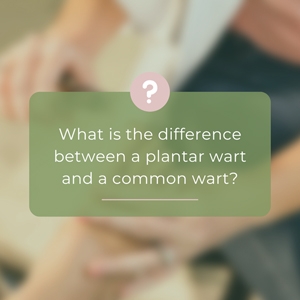Warts are those little, unsightly growths that seem to pop up out of nowhere on your skin. While they might all look alike to the untrained eye, there are actually two different types of warts: plantar and common. So, what's the difference between these two types? Keep reading to find out!
When it comes to warts on the feet, there are two main types: plantar warts and common warts. Both can cause discomfort and pain, but there are some key differences between the two.
Plantar warts are growths that develop on the soles of the feet. They tend to be hard, flat, and can be quite painful when pressure is applied to them. Common warts, on the other hand, can develop anywhere on the feet but are most commonly found around the toes. They are usually softer than plantar warts and not as painful.
Plantar warts are caused by HPV, or human papillomavirus. There are over 100 different types of HPV, and plantar warts are caused by just a few of them. Common warts, on the other hand, can be caused by any type of HPV.
Plantar warts are most common among kids and teens. They start out as small lesions on the bottom of the foot that look a bit like a callus. As the wart grows inward, you'll start to notice black pinpoints on the surface, which are actually tiny drops of clotted blood.
Without treatment, these little warts will grow and keep growing, sometimes up to one inch in diameter.
Many people try to treat warts themselves with home remedies such as duct tape or with over-the-counter solutions salicylic acid. However, there is no scientific evidence to support the use of duct tape for treating plantar warts; duct tape can actually be a skin irritant. And using over-the-counter salicylic acid can be dangerous. We have seen patients come in who have left it on for days and damaged good skin. Check out this YouTube video of a patient who came in after using too many salicylic acid pads.
What happened to that patient is the reason you need to see us or your local podiatrist. We can take care of warts in a safe and effective way. If there is only one or two warts present, we can usually take care of it with trimming and application of a strong medication called canthacur. Trimming is done in the office and is not painful. If there is a cluster of warts or they are large in size, we usually have to do a combination of trimming and laser therapy.
Two of the best tips we can give to help prevent the development of warts are:
- Don’t go barefoot.
- Reduce sweating. Warts thrive in a moist environment, so it’s important to keep your feet dry. Using an antiperspirant, such as Mod Pod Fresh, will help keep your feet dry (and smelling fresh!) throughout the day.
So, we’ve talked about the different types of warts and how to identify them. But what if you have one and you don’t know which kind it is? Don’t worry, we can treat them all the same. If you think you might have a wart, give our office a call at 85-264-1141 or schedule an appointment online. We will be more than happy to help diagnose and treat it. And remember, prevention is key! Make sure to keep your feet clean and dry to reduce your chances of getting a wart in the first place.

